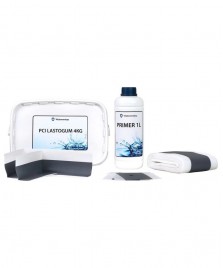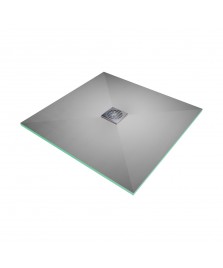- today
- perm_identity Chris Miller
- label Wet Room Kits
- favorite 0 likes
- remove_red_eye 2693 views

For individuals with limited mobility, a wet room can be a game-changer, offering a safe and convenient bathing solution. But one question often lingers in the minds of homeowners: how much does a disabled wet room cost? It's a valid concern, given the myriad of factors that can influence the final price tag. The total cost could depend on the price of labour, tiling, fittings and fixtures, tanking kits for wet rooms and more.
In this guide, we'll peel back the layers and provide a comprehensive breakdown of the cost of installing a disabled wet room in the UK. Whether you're considering a wet room for personal use, for your loved one, or as an investment in a property, we're here to demystify the numbers for you. Let's dive in!
What Does the Average Disabled Wet Room Cost?
When considering installing a disabled wet room, one of the primary concerns for homeowners is the cost.
Compared to other options, such as walk-in showers and baths, wet rooms are a much larger undertaking and are therefore more expensive. This is because they need to be fully waterproofed, and may necessitate changing the layout of the bathroom (e.g. by removing a wall).
In the UK, the average cost of installing a basic wet room is approximately £8,000, with prices typically falling between £4,000 and £12,000. Disabled wet rooms tend to be more expensive, with averages ranging from £10,000 to £15,000. This is because they typically require additional features and fittings such as grab bars, wider doorways and step-free access.
However, it's essential to note that this is a rough figure, and the actual costs can vary significantly based on several factors.
What Factors Can Affect the Cost of Installing a Disabled Wet Room?
When budgeting for a disabled wet room, it's crucial to understand the various elements that contribute to the overall cost. Let's break down these factors to give you a comprehensive understanding of what to expect.
Labour
Labour is one of the significant contributors to the cost of installing a wet room. In the UK, the typical daily rate for installing a wet room (labour only) ranges between £200 and £300. However, this cost can fluctuate depending on things like your geographical location and the demand for services in your area.
Installing a disabled wet room typically takes around a week, though the actual time frame depends on the size and complexity of the job. It's also essential to factor in the potential costs of any additional labour that may be required, such as an electrician or heating engineer.
Room Size and Layout
The size and layout of your new disabled wet room will play a pivotal role in determining the price of the job. A larger room will require more materials, such as tiles, waterproofing and fixtures, leading to a higher overall cost. Additionally, a more complex room layout might necessitate additional work in terms of pipework or structural adjustments, such as removing walls.
Preparation Work Required
Before the actual installation begins, there may be a need for significant preparatory work. This could include tasks such as:
-
Stripping the existing bathroom and disposing of old fixtures and fittings
-
Replacing pipework
-
Adjusting the floor level to create a step-free entrance
-
Fitting a wider doorway to ensure wheelchair accessibility
Ventilation is another critical aspect, especially in wet rooms, to prevent mould growth and ensure a healthy environment. Each of these preparatory tasks adds to the overall cost.
Fixtures and Fittings
The choice of fixtures and fittings can significantly impact how much it costs to install a disabled wet room. For example, opting for a folding glass door will be more expensive than fitting a standard shower screen, which in itself would be a pricier option than a simple shower curtain.
Additionally, disabled wet rooms often require additional safety features such as grab bars, emergency alarm systems and shower seats or benches, further driving up the price.
Quality of Materials
The materials you choose for your wet room, such as the type of wall and floor coverings, taps, shower screen, tray, and waterproofing kit, will also play a substantial role in determining the overall budget.
Higher quality materials often come with a larger price tag, but may be more durable and aesthetically pleasing. Safety should also be a consideration – for example, non-slip flooring may be more expensive than standard tiles, but may be a necessary expense when installing a disabled wet room.
Potential Additional Costs
Beyond the basic installation, there might be optional extras that you wish to incorporate. These may include enhancements like changing the room's lighting, adding underfloor heating for enhanced comfort, or even integrating smart technology. While these additions can elevate the overall experience of the wet room, they also come with their own set of costs.
Can I Install a Disabled Wet Room Myself?
The idea of a DIY project can be tempting, especially when considering the potential savings on labour costs. However, installing a disabled wet room is a complex task that requires expertise in plumbing, tiling and installing tanking (waterproofing). While certain aspects, such as fitting grab bars, may be manageable by a competent DIY enthusiast, the core installation should ideally be left to professionals.
Mistakes in waterproofing or drainage can lead to significant issues down the line, including water damage or mould growth. Moreover, ensuring the room meets safety standards and building regulations is paramount, and professionals are equipped with the knowledge to ensure this.
Can I Get Help with the Cost of Installing a Wet Room?
If you need to install a disabled wet room in the UK, you may be able to save on VAT. If the wet room is specifically designed for a person with a disability, or chronic illness affecting their mobility, you may be exempt from paying the standard 20% VAT. This can result in significant savings.
Additionally, individuals may qualify for a Disabled Facilities Grant (DFG) through their local council. This grant is designed to help cover the costs of essential home adaptations, including wet rooms, to ensure a person's safety and mobility. The amount awarded and eligibility criteria can vary, so it's advisable to check with your local council for specific details.
Choose Wetroomstop: The Tradesman’s Choice
When it comes to sourcing the best products for disabled wet room installation in the UK, Wetroomstop stands out as a top choice. We supply a comprehensive range of high-quality products including shower bases and screens, drainage solutions, tanking kits, underfloor heating mats and more.
Furthermore, we offer a price match guarantee and a competitive trade discount, ensuring contractors and builders get the best value for money – without sacrificing on quality. Contact our helpful team for advice on choosing the right product for your needs.

















